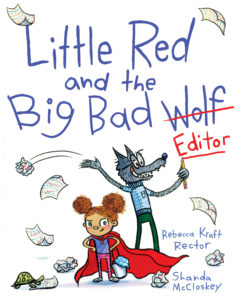“Little Red and the Big Bad Educator’s Guide”
When I learned Shanda McCloskey would be illustrating my story LITTLE RED AND THE BIG BAD EDITOR, I was ecstatic. I knew her art would bring to life my story of the Big Bad Wolf correcting Little Red’s thank you letter to Granny. And I was right. The vibrant colors! The actions! The humor! I was so lucky to be paired with Shanda.
Then I learned Shanda, like me, had an educational background and she wanted to collaborate on an educator’s guide for LITTLE RED AND THE BIG BAD EDITOR. What a great idea! Many publishers and editors provide educator’s guides for their picture books.
There are so many ways to use picture books in classrooms from kindergarten on up. They’re rich in vocabulary and can have a higher reading level than many novels. They’re short and appealing to lower-level readers, ESL, and special needs students. For a generation that enjoys graphic novels and sharing pictures and stories on social media, picture books can be a familiar format. In fact, picture books often introduce new concepts and facts in an accessible way. They are an excellent entry point for all ages about topics that are difficult to understand or discuss.
But what about LITTLE RED AND THE BIG BAD EDITOR? Could we put together a useful educator’s guide for a fun story about correcting a heartfelt but poorly written letter? No problem! I’d done a basic guide for my first picture book SQUISH SQUASH SQUISHED and even produced a short video for a school librarian presentation. My brain was stuffed with methods for meeting curriculum standards after writing lesson plans, test passages, questions and answers for educational publishers.
I told Shanda “Yes!” and got to work.
Like Little Red, I whipped out my crayons (computer) and started writing. And like the Big Bad Wolf, I crumpled up those pages and threw them away. The Big Bad Wolf couldn’t fault me on my capitalization and finger spacing, but there were just too many elements that I wanted to include.
For instance, I could ask students to look for examples of characterization, plot, setting, theme, and story structure. They could practice story prediction by guessing what would happen in the story based on the cover and title.
So many possibilities for discussions and story prompts, too! Students could write their own stories by thinking about what happens before or after the story, or within the pictures. What was Little Red doing before the present arrived? What happened after the last page of the story? What about that little turtle, what’s his story?
Maybe I should focus on figurative language—the assonance, alliteration, similes, idioms, onomatopoeia, etc. in LITTLE RED. Find the simile: “Little Red was pleased as punch. Granny had sent her a present! Red ripped off the wrappings and removed a cape as scarlet as a ripe tomato.”
What about sequencing and cause and effect? Oh, we could use Shanda’s art for that! Which picture shows what comes first, middle, and last? Which picture shows what caused Little Red to write a thank you note?
And I couldn’t forget about compare/contrast! Both SQUISH SQUASH SQUISHED and LITTLE RED are “fractured” versions of folktales. SQUISH SQUASH SQUISHED is considered a modern version of both TOO MUCH NOISE and IT COULD ALWAYS BE WORSE. After reading an original version and the new version, students could compare/contrast the stories for all of the elements listed above, plus author’s voice and even author’s purpose. Younger students could compare/contrast the illustrations for the stories.
Shanda created awesome activities within a week. She even included practice sheets for writing letters and cursive writing. But after a month I still struggled with narrowing down all the possibilities.
Finally, I realized (why did it take me so long?!) that I couldn’t include everything. Some things would have to be left out. But we’re both really happy with the final product and would be thrilled if you’d take a look. It’s on my website https://rebeccakraftrector.wordpress.com and Shanda’s https://www.shandamc.com and here’s a direct link http://ow.ly/IHPC50KffBh.
Published September 6th, 2022 by Aladdin/Simon & Schuster
About the Book: In this clever and playful fractured fairy tale picture book, the Big Bad Wolf is so distracted by Little Red’s poorly written thank you note to her grandmother that he keeps missing the chance to eat her!
Once upon a time, Little Red received a bold new cape from her Granny. She wrote her a thank you note, packed a basket of goodies, and walked through the meadow to Granny’s house. But swish swash SWOOP, the big bad wolf stops her in her tracks, opens his mouth wide, leans in close and…
Sees the note.
Mr. Wolf can’t believe how sloppy the letter is—Red can’t give this to Granny! He corrects her grammar but misses out on his dinner while he’s distracted each time he encounters Red on the path. Can she keep outsmarting the Big Bad Editor and make it all the way to Granny’s house?
About the Author: Rebecca Kraft Rector is a retired librarian and the author of more than thirty fiction and nonfiction books for children. Her cats Ollie and Opal keep her company while she writes. When she isn’t writing and eating chocolate, she’s trying to keep deer out of her garden.
LITTLE RED AND THE BIG BAD EDITOR is Rebecca’s second picture book, coming from Aladdin/Simon & Schuster on September 6, 2022.
Visit Rebecca online at https://rebeccakraftrector.wordpress.com
Thank you, Rebecca, for introducing us to your book and how useful it will be in classrooms and libraries!


